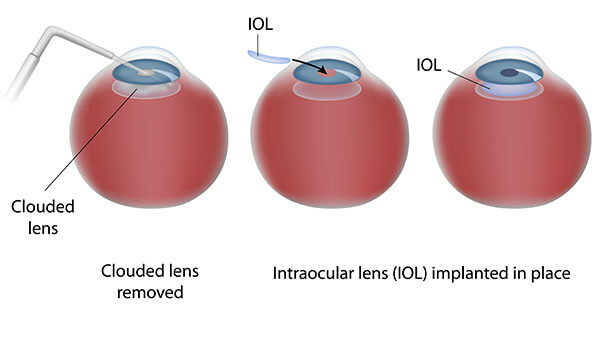Cataract Surgery
At Dr. Esters Eyecare Institute, we specialize in providing comprehensive eye care that goes beyond vision correction. One common condition that we address with expertise is cataracts—a clouding in the typically clear lens of the eye. Let’s explore the nuances of cataracts and the advanced solutions offered by Dr. Esters and his dedicated team.
Understanding Cataracts
Cataracts are not an external film covering the eye, as commonly perceived. Instead, they manifest as cloudiness within the lens, which is located inside the eye, behind the iris. Responsible for focusing light for clear vision, the lens can become cloudy with age or as a side effect of certain medications. The result is blurred vision, affecting daily activities and diminishing the overall quality of life.
While cataracts generally impact both eyes, it’s not uncommon for one eye to have a more pronounced degree of cloudiness, leading to poorer vision in that specific eye. Aging is a significant factor in the development of cataracts, and individuals with a family history are more prone to this condition.
How Are Cataracts Detected?
Cataracts are diagnosed through a comprehensive eye exam conducted by our skilled eye care professionals at Dr. Esters Eyecare Institute. This thorough examination not only identifies cataracts but also assesses for other potential causes of vision deterioration, such as glaucoma or macular degeneration.
It’s crucial to note that while cataract surgery can significantly improve vision, it may not restore perfect vision if other eye diseases are present. Our team is committed to providing a precise diagnosis and developing a tailored treatment plan for each patient’s unique needs.
Treatment Options
As cataracts progress, impacting daily activities like driving, reading, or engaging in recreational pursuits, cataract surgery becomes a viable solution. At Dr. Esters Eyecare Institute, we understand the importance of restoring clear vision to enhance your overall well-being.
Cataract surgery is now performed as an outpatient procedure, typically requiring a two to three-hour stay. The actual surgery, lasting between ten to twenty minutes, is painless and alleviates anxiety through the use of a mild sedative. Using advanced ultrasound technology, the clouded lens is gently removed through a small incision in a bloodless area of the eye. A foldable lens implant is then inserted through the same incision, precisely behind the pupil, where the cataract was located.
Post-surgery, patients are provided with eye drops for a month to reduce infection risk and expedite the healing process. Our commitment to utilizing the latest technologies ensures a secure and self-sealing wound, allowing patients to resume regular activities as soon as possible.
How soon can I return to normal activities after cataract surgery?
Most patients can resume their regular activities shortly after surgery. While some restrictions may apply, such as avoiding heavy lifting or strenuous activities for a few weeks, the majority of day-to-day functions can be resumed almost immediately.
What are the risks associated with cataract surgery?
While complications are rare, as with any surgery, there is a 4-5% chance of potential issues. However, 95% of our patients report significant improvement in their vision after successful cataract surgery.

Premium Lenses

Monofocal
With the standard single focus artificial lens implant (monofocal), you can select which of the four zones you want to see without wearing glasses. You must wear glasses if you want to see any of the other zones.

Bifocal
Bifocal lens implants (multifocal) are designed to produce a dual focus, meaning they can focus on more than one distance. With a bifocal lens implant, part of the lens is set for distance focus (zone 1) while part of the lens is then set for reading distance (zone 4). Having bifocal lens implants can significantly reduce your dependence on reading glasses.

Extended Focus
Extended focus lens implants provide continuous focus over a range of distances. This lens implant is a good option for patients that want good natural focus without glasses when outdoors and indoors distances, as well as at mid-range distances, like zones 1, 2, and 3.

Toric
If the shape of the cornea is imperfect, it creates a natural blur or misfocus called astigmatism. Astigmatism is a refractive error that causes blurry vision. For patients with astigmatism, astigmatism correction can be put into the lens implant instead. This is something easily incorporated into each of the three lens implant categories. Any lens containing astigmatism correction is called a toric lens.
Take the First Step Toward Clear Vision
Do you suspect you might be experiencing cataract symptoms? Take our FREE online cataract self-test and find out if you could benefit from cataract surgery. Your journey to clearer vision begins with Dr. Esters Eyecare Institute – your trusted partner in achieving optimal eye health.
